Connecting With Others
Recently a big issue surrounding Chapman University is the lack of diversity and President Doti’s opposition to a multicultural center. Many of the arguments claim that he has denied students such a center because he’s racist and “colorblind.” However, I entirely disagree with the student population on this, as I myself, am part of a minority demographic and never felt like I was given less opportunities or discriminated against during my time at Chapman. The general argument for a multicultural center in my opinion, has been entirely contradictory. It goes something along the lines of “We want a separate building to discuss diversity and feel more comfortable being around those of our own race, because this is the solution to ultimately feeling inclusive in the Chapman community.” Let’s think about this logically…the argument is that through separation and segregation, we accomplish immersion? Get it together people. The concept of this center is merely an illusion, it symbolizes the effort, but has no real value in terms of contributing to a solution. If you were really passionate about increasing diversity and global citizenship within Chapman University, shouldn’t you want this ideal and value to be present throughout the entire campus, instead of confined to this standalone center? I usually don’t chime into such political conversations, but you know what, the level of ignorance pissed me off. I believe that anyone and everyone can connect with each other regardless of race, age, gender, and anything we were born with. I see everyone as unique individuals with different perspectives and ideas to share, and I see people for their values and ideas, not for their physical appearance. If this is what you consider “colorblind” then so be it, because this is how you build a deeper connection with other people – you look past the color – you look at who they are on the inside, and that’s what matters most.

Below is the letter I sent to President Doti and The Panther Newspaper:
Dear Chapman,
I’ve been seeing a lot of discussion in regards to the topic of a multicultural center and the arguments for and against it, which gave me an urge to share my personal experience with you.
When I visited our gorgeous campus 5 years ago, I just knew it was meant to be. Demographically speaking, I’m a Vietnamese female, first generation college student from a low income household. Yes, this is what the paperwork says, but this is not how I identified myself. And yes, there are a lot of white people and while physically I didn’t look the norm, I never once felt isolated on campus.
At Chapman, I was a Panther, and part of a community of fellow Panthers. I saw myself through the lense of my passions, education, ambitions, the environment I was raised in, and the people I interacted with. From faculty to staff and administrators, I was able to connect with everyone and anyone because we all shared the same values and goals – to be global citizens and lifelong learners. For four years, Chapman was my home, and it remains so today.
I am truly grateful for the experience this community provided me, I love this school so much, you might think I’m obsessed. I’m thankful for all the professors who shared their wisdom and knowledge in the classroom, the students who came from different places and backgrounds who shared their ideas and perspectives, and the administrators who empowered all of us to be better individuals.
While I am no longer in school, I am continuously learning new things every day. Just as I don’t need a classroom to be learning, why do we need a multicultural center in order to discuss diversity? Change doesn’t come from a building, it comes from people. When it comes down to allocating budget for either a building or for people, I’d choose people.
Rather than focusing on things we’re born with like race and gender, why not focus on the things that connect us. If there’s one thing I’ve learned at Chapman, it’s that life is about the relationships you make and the empathy you share with others that makes it a rewarding experience. So let’s just spread some love and positivity no matter where we are on campus, or where we go in the world.
Love,
Chapman Alumna
ABSOLUTE GENIUS
This is just brilliant, and another reason why I will always choose Coca-Cola over Pepsi. Coke can do no wrong! (Except give you diabetes, #firstworldpains). And bonus points for using a song from my homeland.
Can Empathy Create Blue Oceans?
A few months ago I read a book called “Blue Ocean Strategy” which talks about avoiding the competition and creating new “blue” oceans rather than struggling in “red oceans.” Blue oceans refer to industries that are not currently in existence – the unknown market space where demand is created rather than fought for. Companies that follow this route are game changers and innovators who either give rise to completely new industries or alter the boundaries of an existing one. This is the pursuit of value innovation, which simultaneously combines differentiation and low cost (no way!) By leaving the competition behind, the opportunity for growth is both profitable and rapid.
 Sounds great right? Then why isn’t everyone creating blue oceans? Well one of the problems with blue oceans, is that it’s unknown. There are no metrics and past data that can be used to predict the outcome. Being unable to calculate the risk is like taking a shot in the dark. But with great risk comes great reward. Innovation by definition is new and original, it departs from current experiences and behavior, and renders market research obsolete. It’s creating something people want, before they even want it! If we all based our thinking on past data and patterns, innovation wouldn’t exist.
Sounds great right? Then why isn’t everyone creating blue oceans? Well one of the problems with blue oceans, is that it’s unknown. There are no metrics and past data that can be used to predict the outcome. Being unable to calculate the risk is like taking a shot in the dark. But with great risk comes great reward. Innovation by definition is new and original, it departs from current experiences and behavior, and renders market research obsolete. It’s creating something people want, before they even want it! If we all based our thinking on past data and patterns, innovation wouldn’t exist.
I believe the solution to this dilemma, is empathy. By tapping into empathy, we understand people, we can predict their unrealized wants and needs, and we can connect with that through innovation. Empathy is not numbers, it’s not something you can measure empirically. It’s an understanding of both the rational and irrational mindset. It goes beyond asking, “what?” and more towards “why?” The search for empathy is what it means to be a cultural anthropologist.
Great entrepreneurs like Steve Jobs and Henry Ford gave us products we didn’t even know we wanted. Smart phones and cars were inconceivable at the time they were introduced, but look where they are today. Jobs and Ford differentiated between need and want. They differentiated between going against the current, and changing the world in blue oceans. How? It begins with empathy.

Connection Trumps Differentiation
The automotive industry has always been at the peak of my interest. Why do I find this so fascinating? First of all, this is a highly competitive industry, full of major players who have all the resources money can buy. Major players in this industry have extensive financial, technical, manufacturing, marketing, and other resources that give them an advantage in R&D, manufacturing, distribution, and marketing of their products. Other competitors are in a stronger position to respond quickly to new technologies and get products out more effectively while competitors such as GM, Ford, and Toyota have significant economies of scale that allow them to compete with lower starting prices on vehicles.
Innovation is the core of why this market continues to grow and expand, and change. Everyone wants to be the top, everyone wants a sustainable competitive advantage, but thinking sustainable and thinking about long term strategies is no longer the way to go. Adaptation and versatility are essential, and innovation is the norm. The key question here is, what does it take to stand out?
Well, all roads lead to the consumer. The consumer is the reason why businesses exist. The automotive industry is characterized by intense competition with an abundance of options for consumers. From diesel vehicles to hybrids and flex fuel, and a neverending list of brands and options, the variety of choices give consumers high buying power. It’s not so much about what the business can do, but more so about what the consumer wants. This isn’t an industry that competes on a low cost structure, differentiation is essential. But differentiation for differentiation’s sake is not the point. The point is, to differentiate through connection. Connection is the key, it’s how a brand communicates to the consumer that they understand them, that they share the same worldviews. Connection is relevance. Connection is trust.


